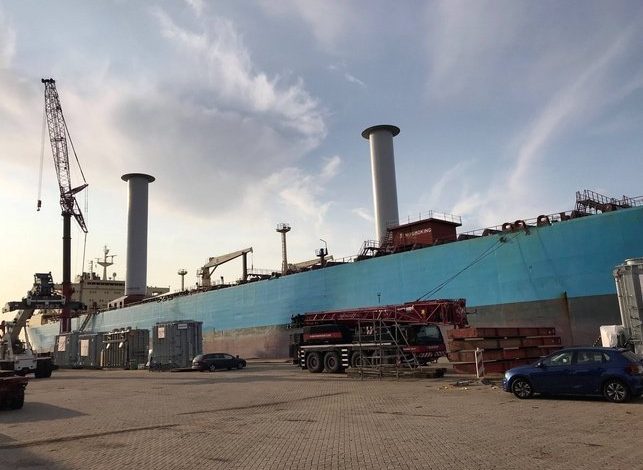Maersk product tanker fitted with rotor sails

Maersk Tankers is trialling wind propulsion as a way to fight soaring bunker bills. Two 30 m tall rotor sails have been installed onboard the LR2 product tanker vessel Maersk Pelican (pictured) targeting a reduction in fuel cost and associated emissions on typical global shipping routes of 7% to 10%.
The rotor sails have been developed by Norsepower and the project also sees Shell and the Energy Technologies Institute taking part.
The rotor sails are large, cylindrical mechanical sails that spin to create a pressure differential – called the Magnus effect – that propels the vessel forward.
The rotor sails are the world’s largest at 30 m tall by 5 m in diameter and were installed on the product tanker vessel in the port of Rotterdam. The first voyage with the rotor sails installed will commence shortly.
“This project is breaking ground in the product tanker industry. While the industry has gone through decades of technological development, the use of wind propulsion technology onboard a product tanker vessel could take us to a new playing field. This new technology has the potential to help the industry be more cost-competitive as it moves cargoes around the world for customers and to reduce the environmental impact,” said Tommy Thomassen, chief technical officer, Maersk Tankers.

Reed: New technology !
–> see: Wikipedia
File:Buckau Flettner Rotor Ship LOC 37764u.jpg
Showing a picture from 1924 !
That time new technology!
Now 94 years ago…
By the way the ratio wind power and ship size was much bigger.
However, there is much more information on the German Wikipedia site and worth give it a view.
Not only how it works, but also, why use stopped…
Right.
Nothing new here.
Should you be really interested, there is some detailed information online available with regard to design, construction and benefits: type after https: followed by // following, or search for:
http://www.ship-efficiency.org/onTEAM/pdf/06-STG_Ship_Efficiency_2013_100913_Paper.pdf
Furthermore it has been reported that the efficiency of the rotors has been about 15% = 5200 tons CO2/year
Following can be found too: 1 ton HFO produces 3,11 ton CO2
(source http://www.engineeringtoolbox.com/co2-emission-fuels-d_1085.html)
A reduction of annual 15% being 5200 tons of CO2 = 1,672 ton HFO
or 5200/3,15 = 1650 ton diesel
Basis MGO and presently 750 USD/mton = 1.237.500 USD of savings per year.
—
Question remains: How much tons of CO2 has been produced to get this installation working.
And the question regarding the break-even time for the installation itself?
—
Regarding Tesla we learned from Sweden that the battery is the ‘killer’ (17 tons CO2, model S) and that it would be better to use a regular car to absolve the first 80.000 km… That would be around 4 years of driving and knowing that the battery needs to be replaced after 1000 – 3000 charging processes, another 17 tons of CO2 again, or better use a smaller battery?
Leaving a lot to be improved before eco-friendly systems like that really work.
Of course you do everything to make fuel really expensive in order to calculate it financially healthy, but remember: The tons of CO2 for production has not been saved, not for batteries, not for rotors and same for wind turbines, their maintenance and finally decommission.